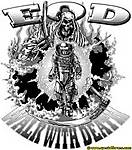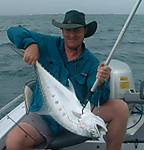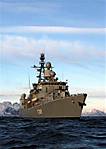The results of the community vote clearly decided that my next large build was going to be Trumpeter's 1/350 scale USS Yorktown with the Pontos Upgrade kit.
With that decision made this will be the build log for that build.

Specifications(As built, 1943)
Displacement: 27,100 tons standard; 36,200 tons full load
Dimensions (wl): 820' x 93' x 28.3' (full load) / 249.9 x 28.3 x 8.6 (full load) meters
Dimensions (max.): 872' x 147.5' / 265.8 x 45 meters
Armor: 4"-2.5" belt; 1.5" hangar & protective deck(s); 4" bulkheads; 1.5" STS (top, side of pilot house); 2.5" (top) steering gear
Power plant: 8 boilers (565 psi, 850°F); 4 steam turbines; 4 shafts; 150,000 shp (design)
Speed: 32.7 knots
Endurance (design): 20,000 nautical miles @ 15 knots
Armament: 4 twin & 4 single 5"/38 gun mounts; 8 quad 40-mm/56-cal gun mounts; 46 single 20-mm/70-cal guns mounts
Aircraft: 91 (Air Group 5, October–December 1943)
Aviation facilities: 1 deck-edge, 2 centerline elevators; 2 H4B hydraulic catapults (1 flight deck, 1 hangar deck)
Crew: 2,600+ (ship's company + air wing, as designed)
A little of her history:
USS YORKTOWN was laid down on 1 December 1941 at Newport News, Va., by the Newport News Shipbuilding & Drydock Co. as BON HOMME RICHARD; renamed YORKTOWN on 26 September 1942; launched on 21 January 1943, sponsored by Mrs. Eleanor Roosevelt; and commissioned on 15 April 1943 at the Norfolk Navy Yard, Capt. Joseph J. ("Jocko") Clark in command.
YORKTOWN remained in the Norfolk area until 21 May 1943 at which time she got underway for shakedown training in the vicinity of Trinidad. She returned to Norfolk on 17 June and began post-shakedown availability. The aircraft carrier completed repairs on 1 July and began air operations out of Norfolk until the 6th. On the latter day, she exited Chesapeake Bay on her way to the Pacific Ocean.
She transited the Panama Canal on 11 July and departed Balboa on the 12th. The warship arrived in Pearl Harbor on 24 July 1943 and began a month of exercises in the Hawaiian Islands. On 22 August, she stood out of Pearl Harbor, bound for her first combat of the war. Her task force, TF 15, arrived at the launching point about 128 miles from Marcus Island early on the morning of 31 August. She spent most of that day launching fighter and bomber strikes on Marcus Island before beginning the retirement to Hawaii that evening. The aircraft carrier reentered Pearl Harbor on 7 September and remained there for two days.
On the 9th, she stood out to sea, bound for the west coast of the United States. She arrived in San Francisco on 13 September, loaded aircraft and supplies, and returned to sea on the 15th. Four days later, the aircraft carrier reentered Pearl Harbor. After 10 days in the Hawaiian Islands, YORKTOWN returned to sea to conduct combat operations on the 29th. Early on the morning of 5 October 1943, she began two days of air strikes on Japanese installations on Wake Island. After retiring to the east for the night, she resumed those air raids early on the morning of the 6th and continued them through most of the day. That evening, the task group began its retirement to Hawaii. YORKTOWN arrived at Oahu on 11 October and, for the next month, conducted air training operations out of Pearl Harbor.
On 10 November, YORKTOWN departed Pearl Harbor in company with Task Force (TF) 50 — the Fast Carrier Forces, Pacific Fleet — to participate in her first major assault operation, the occupation of certain of the Gilbert Islands. On the 19th, she arrived at the launch point near Jaluit and Mili and, early that morning, launched the first of a series of raids to suppress enemy air-power during the amphibious assaults on Tarawa, Abemama, and Makin. On the 20th, she not only sent raids back to the airfield at Jaluit but some of her planes also supported the troops wresting Makin from the Japanese. On 22 November, her air group concentrated upon installations and planes at Mili once again. Before returning to Pearl Harbor, the aircraft carrier made passing raids on the installations at Wotje and Kwajalein Atolls on 4 December 1943. The warship reentered Pearl Harbor on 9 December and began a month of air training operations in the Hawaiian Islands.

On 16 January 1944, the warship exited Pearl Harbor once again to support an amphibious assault, Operation Flintlock, the Marshall Islands operation. Her task group, Task Group (TG) 58.1, arrived at its launching point early on the morning of 29 January, and its carriers - YORKTOWN, USS LEXINGTON (CV 16), and USS COWPENS (CVL 25) - began sending air strikes aloft at about 0520 for attacks on Taroa airfield located on Maloelap Atoll. Throughout the day, her aircraft hit Maloelap in preparation for the assaults on Majuro and Kwajalein scheduled for the 31st. On the 30th,YORKTOWN and her sister carriers shifted targets to Kwajalein to begin softening up one of the targets itself. When the troops stormed ashore on January 31st, YORKTOWN aviators continued their strikes on Kwajalein in support of the troops attacking that atoll. The same employment occupied the YORKTOWN air group during the first three days in February. On the 4th, however, the task group retired to the Fleet anchorage at recently secured Majuro Atoll.
Over the next four months, YORKTOWN participated in a series of raids in which she ranged from the Marianas in the north to New Guinea in the south. After eight days at Majuro, she sortied with her task group on 12 February 1944 to conduct air strikes on the main Japanese anchorage at Truk Atoll. Those highly successful raids occurred on 16 and 17 February. On the 18th, the carrier set a course for the Marianas and, on the 22nd, conducted a single day of raids on enemy airfields and installations on Saipan. That same day, she cleared the area on her way back to Majuro. The warship arrived in Majuro lagoon on 26 February and remained there, resting and replenishing until 8 March. On the latter day, the carrier stood out of Majuro, rendezvoused with the rest of TF 58, and shaped a course for Espiritu Santo in the New Hebrides. She reached her destination on 13 March and remained there for 10 days before getting underway for another series of raids on the Japanese middle defense line. On 30 and 31 March, she launched air strikes on enemy installations located in the Palau Islands; and, on 1 April, her aviators went after the island of Woleai. Five days later, she returned to her base at Majuro for a week of replenishment and recreation.

On 13 April 1944, YORKTOWN returned to sea once more. On this occasion however, she laid in a course for the northern coast of New Guinea. On 21 April, she began launching raids in support of General Douglas MacArthur's assault on the Hollandia area. That day, her aviators attacked installations in the Wakde-Sarmi area of northern New Guinea. On the 22nd and 23rd, they shifted to the landing areas at Hollandia themselves and began providing direct support for the assault troops. After those attacks, she retired from the New Guinea coast for another raid on Truk lagoon, which her aircraft carried out on 29 and 30 April. The aircraft carrier returned to Majuro on 4 May; however, two days later she got underway again, bound for Oahu. The warship entered Pearl Harbor on 11 May and, for the next 18 days, conducted training operations in the Hawaiian Islands. On 29 May, she headed back to the central Pacific. YORKTOWN entered Majuro lagoon again on 3 June and began preparations for her next major amphibious support operation - the assault on the Marianas.
On 6 June 1944, the aircraft carrier stood out of Majuro with TF 58 and set a course for the Mariana Islands. After five days steaming, she reached the launch point and began sending planes aloft for the preliminary softening up of targets in preparation for the invasion of Saipan. YORKTOWN aircrews concentrated primarily upon airfields located on Guam. Those raids continued until the 13th when YORKTOWN, with two of the task groups of TF 58, steamed north to hit targets in the Bonin Islands. That movement resulted in a one-day raid on the 16th before the two task groups headed back to the Marianas to join in the Battle of the Philippine Sea. Task Force 58 reunited on 18 June and began a short wait for the approaching Japanese Fleet and its aircraft.
On the morning of 19 June 1944, YORKTOWN aircraft began strikes on Japanese air bases on Guam in order to deny them to their approaching carrier-based air and to keep the land-based planes out of the fray. Duels with Guam-based aircraft continued until mid-morning. At about 1017, however, she got her first indication of the carrier plane attacks when a large bogey appeared on her radar screen. At that point she divided her attention, sending part of her air group back to Guam and another portion of it out to meet the raid closing from the west. Throughout the battle, YORKTOWN's planes continued both to strike the Guam airfields and intercept the carrier raids. During the first day of the Battle of the Philippine Sea, YORKTOWN aircraft claimed 37 enemy planes destroyed and dropped 21 tons of bombs on the Guam air bases.
On the morning of the 20th YORKTOWN steamed generally west with TF 58 while search planes groped for the fleeing enemy task force. Contact was not made with the enemy until about 1540 that afternoon when a USS HORNET (CV 12) pilot spotted the retiring Combined Fleet units. YORKTOWN launched a 40-plane strike between 1623 and 1643 and sent it winging after the Japanese. Her planes found Admiral Ozawa's force at about 1840 and began a 20-minute attack during which they went after ZUIKAKU on whom they succeeded in scoring some hits. They, however, failed to sink that carrier. They also attacked several other ships in the Japanese force though no records show a confirmed sinking to the credit of the YORKTOWN air group. On 21 June, the carrier joined in the futile stern chase on the enemy carried out by TF 58 but gave up that evening when air searches failed to contact the Japanese. YORKTOWN returned to the Marianas area and resumed air strikes on Pagan on June 22 and 23. On the 24th, she launched another series of raids on Iwo Jima. On 25 June, she laid in a course for Eniwetok and arrived there two days later. On the 30th, the aircraft carrier headed back to the Marianas and the Bonins. She renewed combat operations on 3 and 4 July with a series of attacks on Iwo Jima and Chichi Jima. On the 6th the warship resumed strikes in the Marianas and continued them for the next 17 days. On 23 July, she headed off to the west for a series of raids on Yap, Ulithi, and the Palaus. She carried out those attacks on 25 July and arrived back in the Marianas on the 29th.
On July 31, 1944, she cleared the Mariana Islands and headed, via Eniwetok and Pearl Harbor, back to the United States. YORKTOWN arrived in the Puget Sound Navy Yard on 17 August and began a two-month overhaul. She completed repairs on 6 October and departed Puget Sound on the 9th. She stopped at the Alameda Naval Air Station from 11 to 13 October to load planes and supplies and then set a course back to the western Pacific. After a stop at Pearl Harbor from the 18th to the 24th, YORKTOWN arrived back in Eniwetok on 31 October 1944. She departed the lagoon on 1 November and arrived at Ulithi on the 3rd. There, she reported for duty with TG 38.4. That task group left Ulithi on 6 November, and YORKTOWN departed with it.
(History Continues
In February 1970, YORKTOWN transferred to Quonset Point, R.I., and was relieved by USS INTREPID (CVS 11) as the flagship for Commander Carrier Group 16. On 27 June 1970, YORKTOWN was decommissioned at Philadelphia, Pa., and was berthed with the Philadelphia Group, Atlantic Reserve Fleet. She remained there almost three years before her name was struck from the Navy list on 1 June 1973. During 1974, the Navy Department approved the donation of YORKTOWN to the Patriot's Point Development Authority, Charleston, S.C. She was towed from Bayonne, N.J., to Charleston S.C., in June of 1975. She was formally dedicated as a memorial on the 200th anniversary of the Navy, 13 October 1975.
USS YORKTOWN earned 11 battle stars and the Presidential Unit Citation during World War II and five battle stars for Vietnam service.
I will be building the USS Yorktown in her 1944 fit preparing to launch her aircraft after the IJN Aircraft Carrier Zuikaku.
KIT: Trumpeter's 1/350 Scale USS Yorktown CV10 1944
Upgrade Kit: Pontos USS Yorktown Upgrade Set
Accessories: 1/350 Trumpeter Aircraft Sets (F4F, TBD, SBC2D)
Gator Mask for Camouflage Measure 33, Design 10a
References:
1) USS Yorktown CV10 (Warship Data 5)
2) Shipcraft 12 - Essex Class Aircraft Carriers
3) NAVSOURCE Website
4) Patriot's Point, SC - The USS Yorktown
Here is a picture of the Pontos Kits
The Pontos kit comes with everything a builder could need to build this kit. Just to cover a couple of items it has brass masts, resin dual 5" guns, brass 20mm Oerlinken's, all the brass barrels, the MK51 40mm Gun Director, and a ton of brass.
I first began with the hull. Even though I will be mounting her in an ocean scene preparing to launch aircraft I mounted the full hull instead of the waterline.
The fir was good but definitely not perfect. A recommendation to future builders would be the removal or cutting of the bracing bars seen in the first picture. I recommend this because they are a little wider than the hull bottom and it requires a good bit of pressure to ensure the upper hull fits correctly into the grove.
I failed to notice this during the dry fit. By removing or cutting those bars a builder should be able to manipulate the upper hull a little easier.
After the glue dried I spent a good bit of time sanding the sides to make them even. It was successful in that the overlap is not as pronounced as it had been but it is still there a little.
More sanding to go though.
The next step was mounting the hanger deck to the hull.
The hanger deck comes in three separate pieces. The fit was good but the middle deck did require a little plastic removed from the front port corner to get it to sit flush.
There still remains some gaps around the deck but nothing that cant be fixed with some gap filler.
Here is an overall shot.
The mid deck sheet and the aft deck sheet fit well but there is a noticeable seam that will require some putty.
as you can see in the picture it is unfortunate that the seam is placed close to some deck plating detail.
Well that is as far as I went with this session. I am still planning out the build and will have another update later in the week.
Take care and thanks for stopping by. All comments, suggestions, and criticism are always welcome.
Dave






































